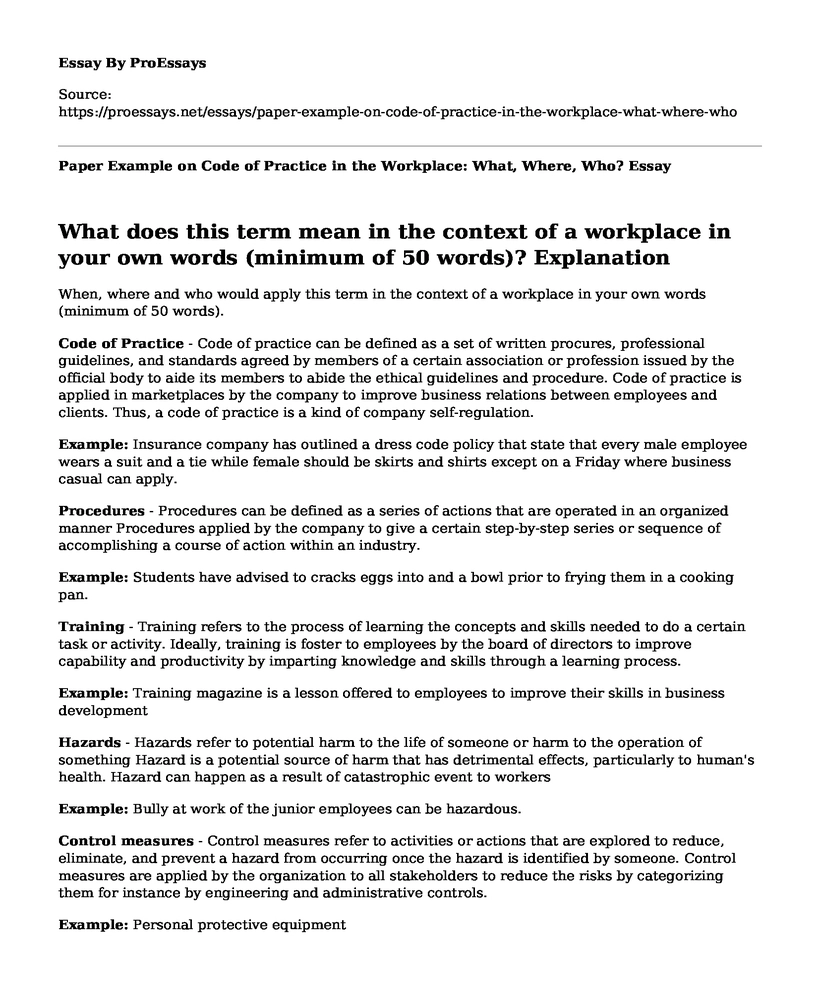What does this term mean in the context of a workplace in your own words (minimum of 50 words)? Explanation
When, where and who would apply this term in the context of a workplace in your own words (minimum of 50 words).
Code of Practice - Code of practice can be defined as a set of written procures, professional guidelines, and standards agreed by members of a certain association or profession issued by the official body to aide its members to abide the ethical guidelines and procedure. Code of practice is applied in marketplaces by the company to improve business relations between employees and clients. Thus, a code of practice is a kind of company self-regulation.
Example: Insurance company has outlined a dress code policy that state that every male employee wears a suit and a tie while female should be skirts and shirts except on a Friday where business casual can apply.
Procedures - Procedures can be defined as a series of actions that are operated in an organized manner Procedures applied by the company to give a certain step-by-step series or sequence of accomplishing a course of action within an industry.
Example: Students have advised to cracks eggs into and a bowl prior to frying them in a cooking pan.
Training - Training refers to the process of learning the concepts and skills needed to do a certain task or activity. Ideally, training is foster to employees by the board of directors to improve capability and productivity by imparting knowledge and skills through a learning process.
Example: Training magazine is a lesson offered to employees to improve their skills in business development
Hazards - Hazards refer to potential harm to the life of someone or harm to the operation of something Hazard is a potential source of harm that has detrimental effects, particularly to human's health. Hazard can happen as a result of catastrophic event to workers
Example: Bully at work of the junior employees can be hazardous.
Control measures - Control measures refer to activities or actions that are explored to reduce, eliminate, and prevent a hazard from occurring once the hazard is identified by someone. Control measures are applied by the organization to all stakeholders to reduce the risks by categorizing them for instance by engineering and administrative controls.
Example: Personal protective equipment
HACCP - HACCP refers to an internationally perceived system recognized in reducing the safety hazard risk in food As a systematic preventive system, HACCP is applied for food safety by food handlers from physical, chemicals, and biological production process that causes the products to be unsafe.
Example: Water quality management
NSQHS - Refers to a scheme designed to give consistent and high-quality safety level and care in every health services within Australia The scheme is developed by the Australian Commission on safety and quality Health service to coordinate accreditation processes across the country health service organization.
Example: As provided in eighth NSQHS standard there is a nationally consistent statement concerning the consumer level of care they expect from health services.
NHMRC - Refers to Australia's peak body that gives support to medical and health research such as developing health advice to Australia's denizens Since NHMRC supports health and medical research, the advice may be intended to governments, health professionals, and community to have good ethical behaviors.
Example: Consumer and community engagement
Legislation - The legislation refers to the process law enactment. At the workplace, legislation is applied to determine employee's rights and responsibility in connection with their employers or leaders.
Example: The new state law of Obamacare
Client - Refers to an organization or individual that needs the services of a professional person At the workplace, clients such as patients may be in dire need of the doctor services in terms of treatment
Example: Patients in the hospital
ACHS - ACHS is defined as an independent non-profit organization that aims at improving Australia' health care quality by assessment and accreditation, continual review of performance capturing specific focus on safety, and quality performance. At the workplace, especially hospital, clinician apply this tool to monitor clinical responses
Example: ACHS care evaluation program
Workplace health and safety - Refers to discipline that aims at protecting stakeholder's safety and health from risks and hazard exposure as a result of work Applied by the organization to all of its members
Example: Australia' code of practice for Safe Design of structure.
Infection Control - Refers to the scientific approach and practical unit that deals with prevention of nosocomial and associated infection Applied by a health professional to patients and other health workers to reduce the dissemination of infection
Example: The World Health Organization Infection Prevention and Control in Health Care initiative
Hierarchy of controls - Hierarchy of control is defined as a system adopted by an organization to completely eliminate or minimize exposure to hazard The concept is used by managers, to help in promoting the standard practice in the industry
Example: Health and Safety handbook
Cite this page
Paper Example on Code of Practice in the Workplace: What, Where, Who?. (2023, Feb 12). Retrieved from https://proessays.net/essays/paper-example-on-code-of-practice-in-the-workplace-what-where-who
If you are the original author of this essay and no longer wish to have it published on the ProEssays website, please click below to request its removal:
- Pharmaceutical, Work Health and Safety Legislation
- Alternative Work Arrangements and Work-Family Balance Essay
- Entrepreneur Analysis Paper Example
- Essay on Understanding Team Members' Behaviors for Optimal Group Performance
- Essay Example on HRM Strategies: Driving Organizational Success Through Employee Performance
- Essay Sample on Master of Social Work: Pursuing a Career in Care Specialist
- Essay Example on 9/11 WTC Attack: Occupational Hazards & Litigation







